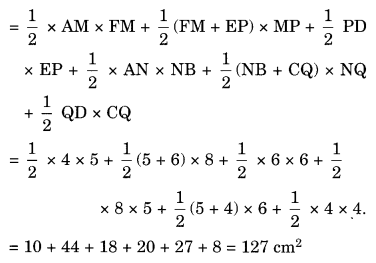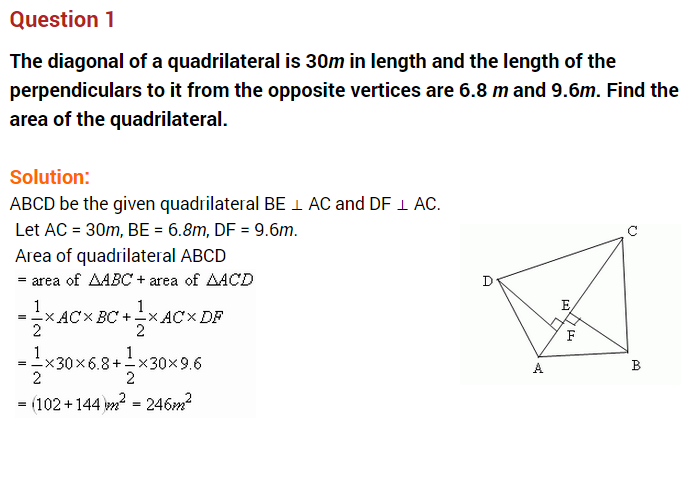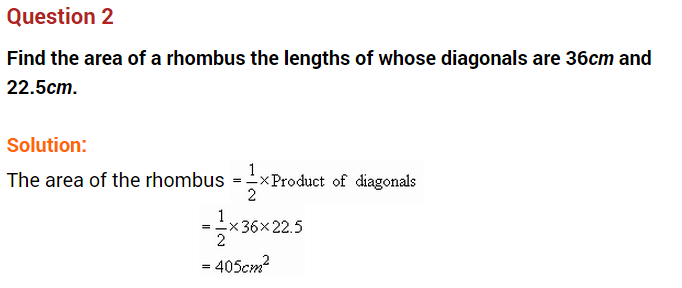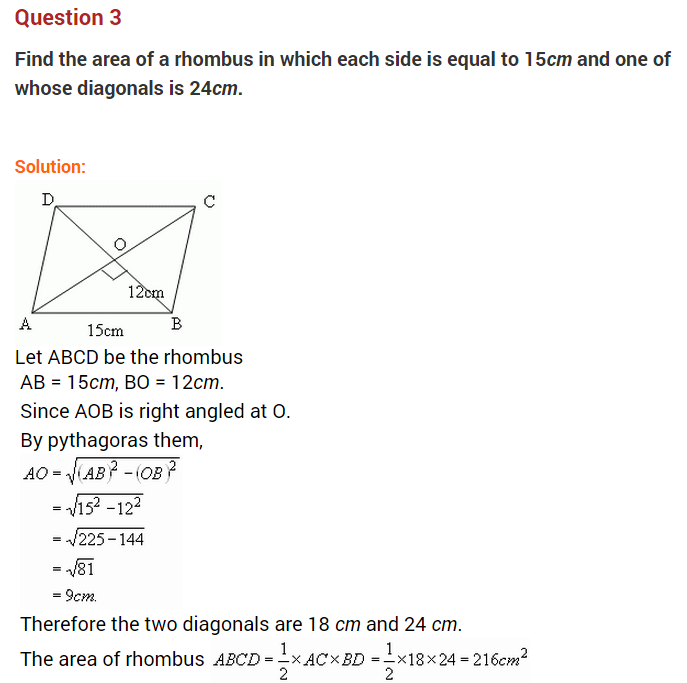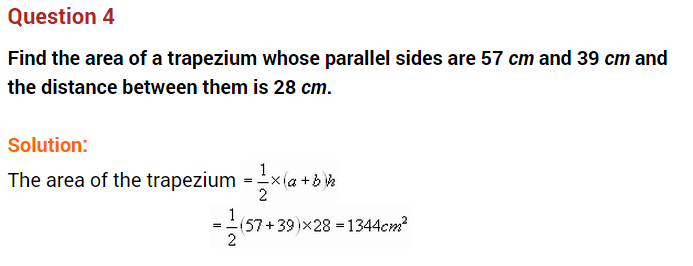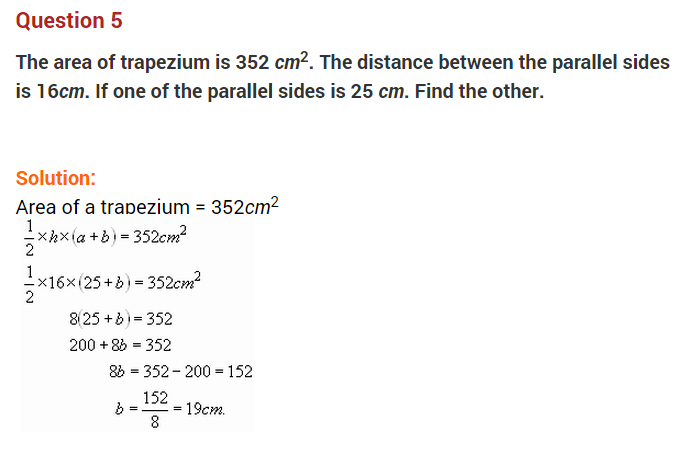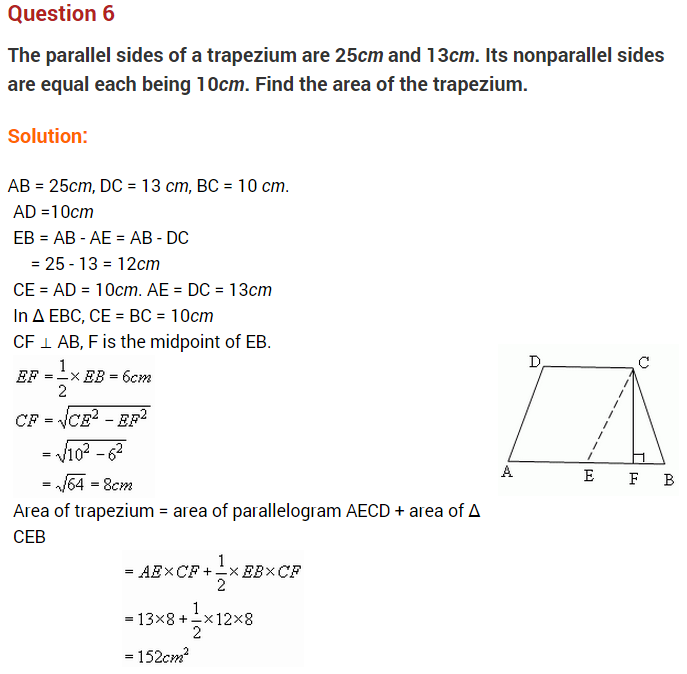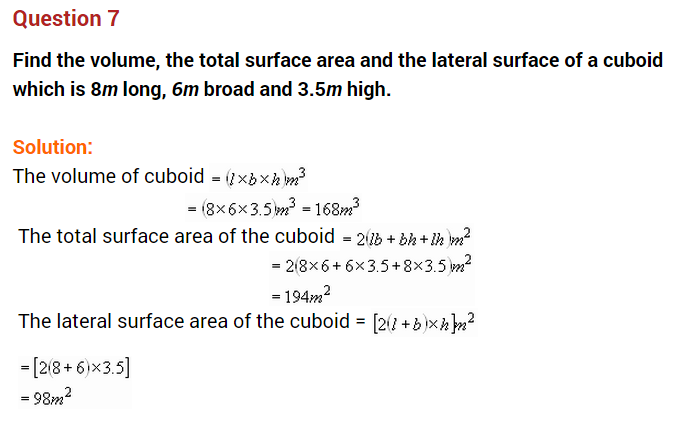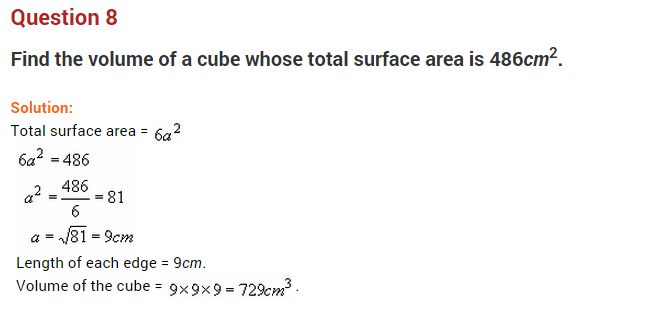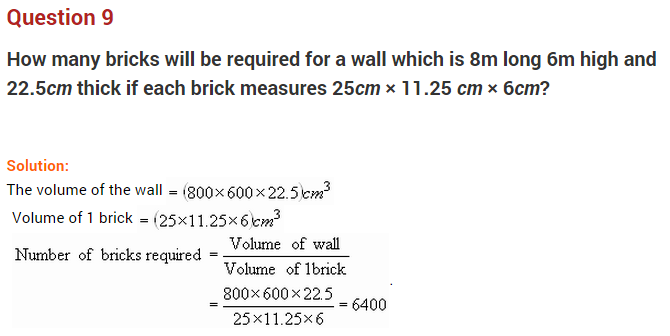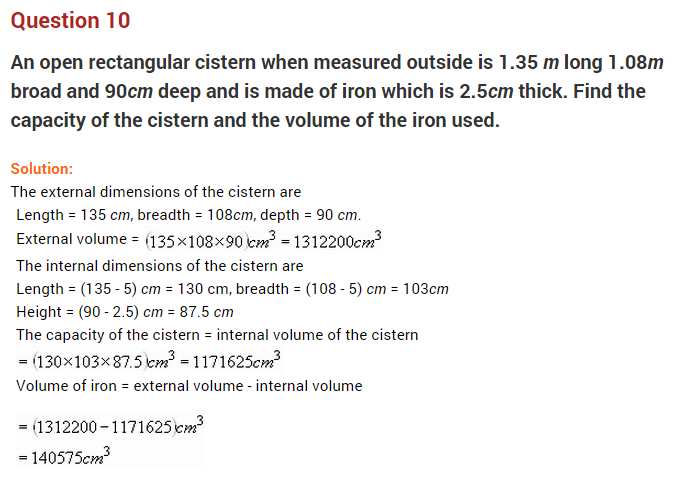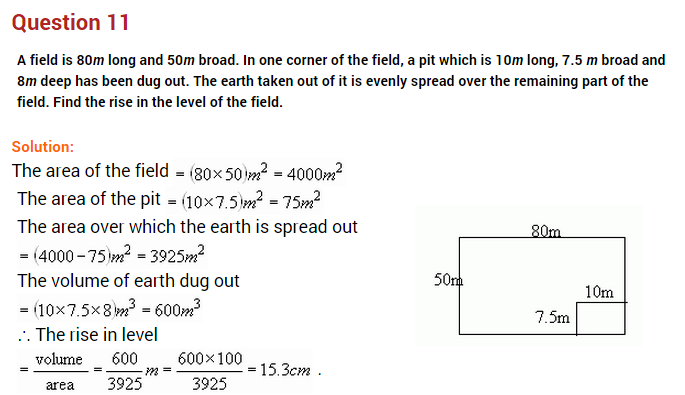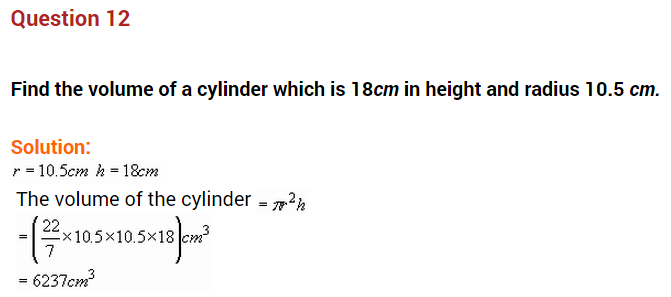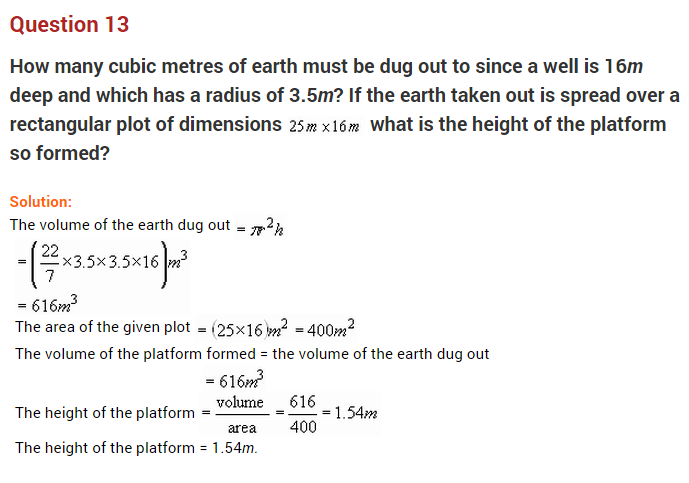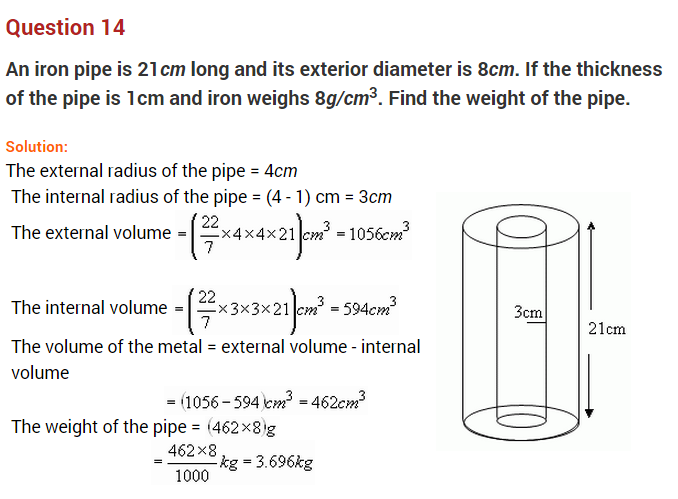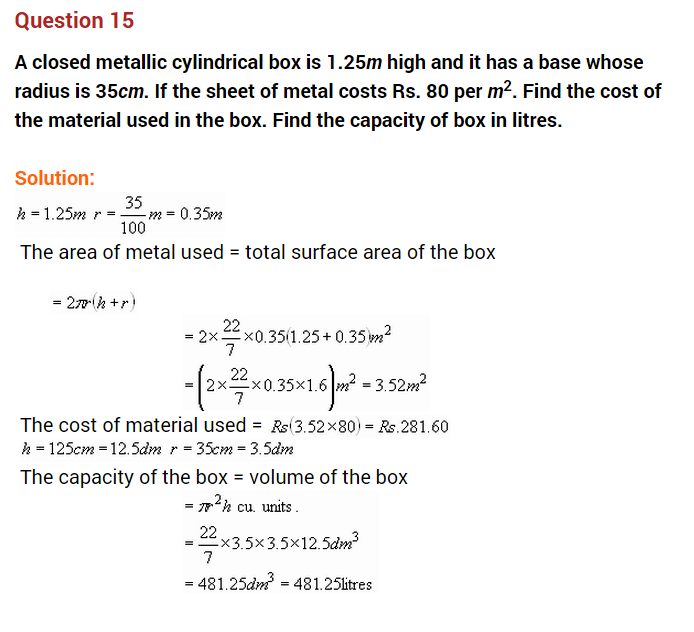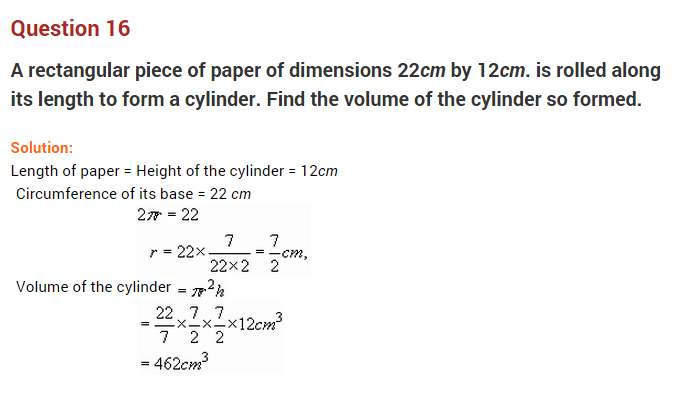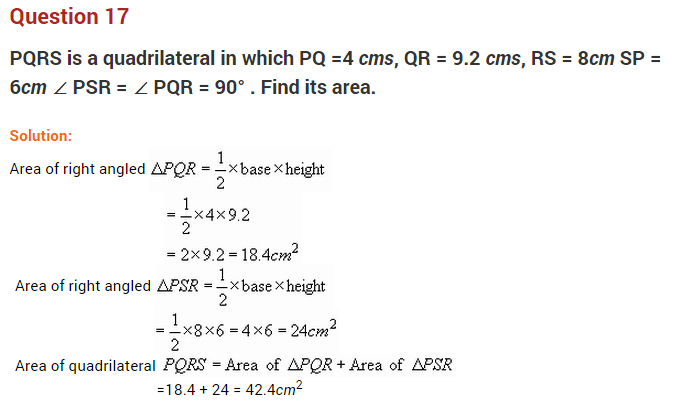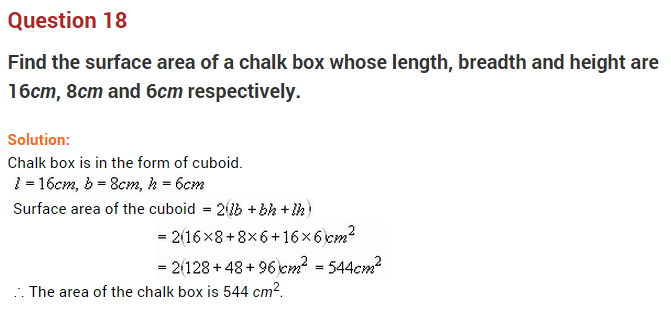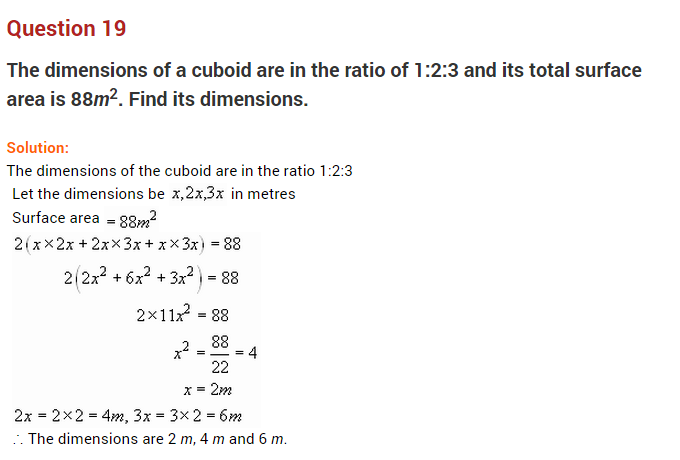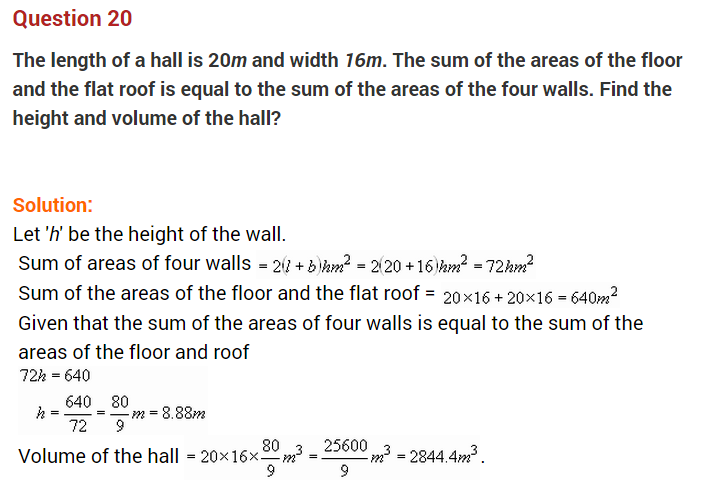Chapter 11 Mensuration
Very Short Answer Type
Question 1.
Find the perimeter of the following figures:
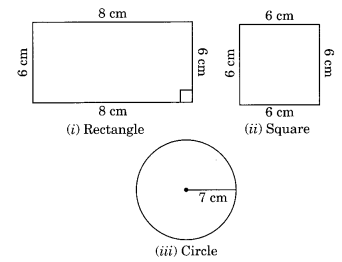
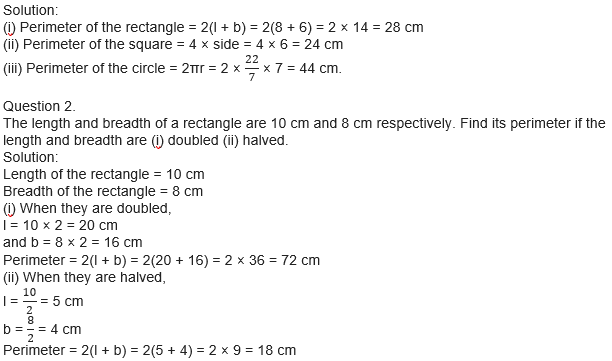

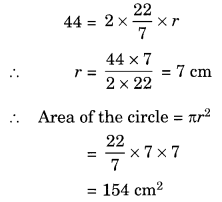
So, the circle will have a larger area.
Question 4.
The length and breadth of a rectangle are in the ratio 4 : 3. If its perimeter is 154 cm, find its length and breadth.
Solution:
Let the length of the rectangle be 4x cm and that of breadth = 3x cm
Perimeter = 2(l + b) = 2(4x + 3x) = 2 × 7x = 14x cm
14x = 154
x = 11
Length = 4 × 11 = 44 cm
and breadth = 3 × 11 = 33 cm
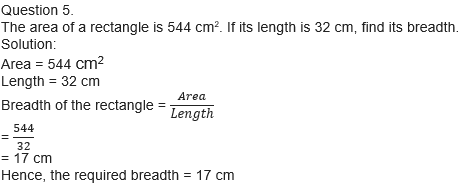
Question 6.
If the side of a square is doubled then how much time its area becomes?
Solution:
Let the side of the square be x cm.
Area = (side)2 = x2 sq. cm
If its side becomes 2x cm then area = (2x)2 = 4x2 sq. cm
Ratio is x2 : 4x2 = 1 : 4
Hence, the area would become four times.
Question 7.
The areas of a rectangle and a square are equal. If the length of the rectangle is 16 cm and breadth is 9 cm, find the side of the square.
Solution:
Area of the square = Area of the rectangle = 16 × 9 = 144 cm2
Side of the square = √Area of the square = √144 = 12 cm
Hence, the side of square = 12 cm.
Question 8.
If the lengths of the diagonals of a rhombus are 16 cm and 12 cm, find its area.
Solution:
Given:
First diagonal d1 = 16 cm
Second diagonal d2= 12 cm
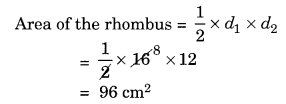
Hence, the required area = 96 cm2.
Question 9.
The area of a rhombus is 16 cm2. If the length of one diagonal is 4 cm, find the length of the other diagonal.
Solution:
Given: Area of the rhombus = 16 cm2
Length of one diagonal = 4 cm
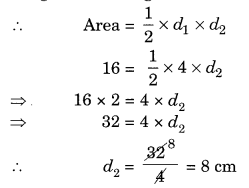
Hence, the required length = 8 cm.
Question 10.
If the diagonals of a rhombus are 12 cm and 5 cm, find the perimeter of the rhombus.
Solution:
Given: d1 = 12 cm, d2 = 5 cm

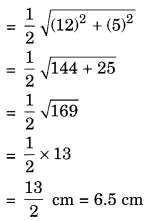
The perimeter = 4 × side = 4 × 6.5 = 26 cm
Hence, the perimeter = 26 cm.
Short Answer Type
Question 11.
The volume of a box is 13400 cm3. The area of its base is 670 cm2. Find the height of the box.
Solution:
Volume of the box = 13400 cm3
Area of the box = 670 cm2

Hence, the required height = 20 cm.
Question 12.
Complete the following table; measurement in centimetres.
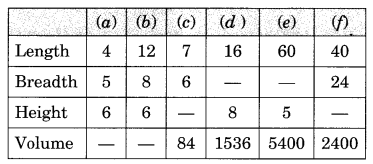
Solution:
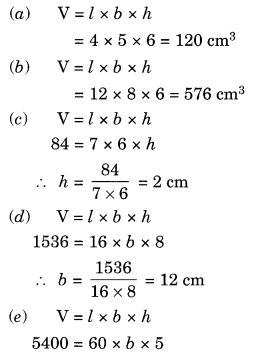
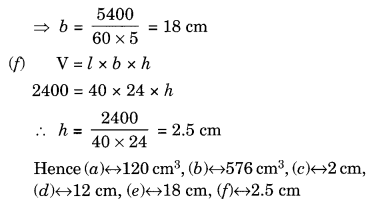
Question 13.
Two cubes are joined end to end. Find the volume of the resulting cuboid, if each side of the cubes is 6 cm.
Solution:
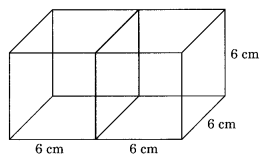
Length of the resulting cuboid = 6 + 6 = 12 cm
Breadth = 6 cm
Height = 6 cm
Volume of the cuboid = l × b × h = 12 × 6 × 6 = 432 cm3
Question 14.
How many bricks each 25 cm by 15 cm by 8 cm, are required for a wall 32 m long, 3 m high and 40 cm thick?
Solution:
Converting into same units, we have,
Length of the wall = 32 m = 32 × 100 = 3200 cm
Breadth of the wall = 3 m = 3 × 100 = 300 cm
and the height = 40 cm
v, length of the brick = 25 cm
breadth = 15 cm
and height = 8 cm
Number of bricks required
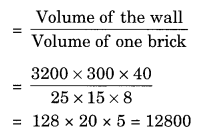
Hence, the required number of bricks = 12800.
Question 15.
MNOPQR is a hexagon of side 6 cm each. Find the area of the given hexagon in two different methods.
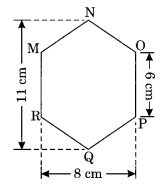
Solution:
Method I: Divide the given hexagon into two similar trapezia by joining QN.
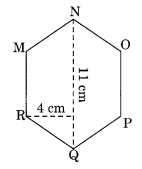
Area of the hexagon MNOPQR = 2 × area of trapezium MNQR
![]()
= 17 × 4
= 68 cm2
Method II: The hexagon MNOPQR is divided into three parts, 2 similar triangles and 1 rectangle by joining MO, RP.
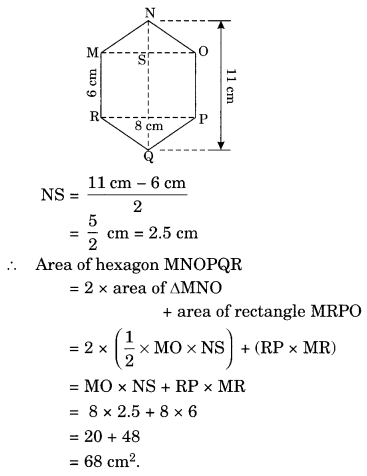
Question 16.
The area of a trapezium is 400 cm2, the distance between the parallel sides is 16 cm. If one of the parallel sides is 20 cm, find the length of the other side.
Solution:
Given: Area of trapezium = 400 cm2
Height = 16 cm
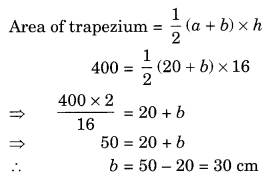
Hence, the required length = 30 cm.
Question 17.
Find the area of the hexagon ABCDEF given below. Given that: AD = 8 cm, AJ = 6 cm, AI – 5 cm, AH = 3 cm, AG = 2.5 cm and FG, BH, EI and CJ are perpendiculars on diagonal AD from the vertices F, B, E and C respectively.
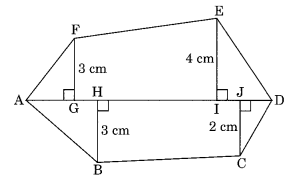
Solution:
Given:
AD = 8 cm
FG = 3 cm
AJ = 6 cm
EI = 4 cm
AI = 5 cm
BH = 3 cm
AH = 3 cm
CJ = 2 cm
AG = 2.5 cm
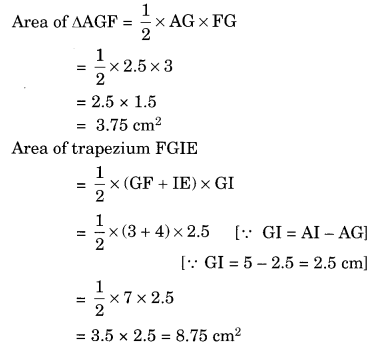
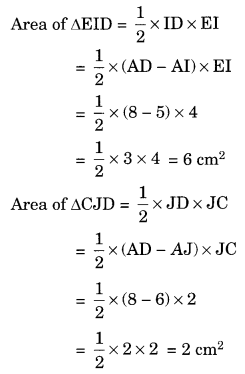
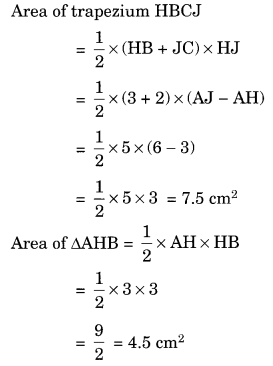
Area of hexagon ABCDEF = Area of ΔAGF + Area of trapezium FGIE + Area of ΔEID + Area of ΔCJD + Area of trapezium HBCJ + Area of ΔAHB
= 3.75 cm2 + 8.75 cm2 + 6 cm2 + 2 cm2 + 7.5 cm2 + 4.5 cm2
= 32.50 cm2.
Question 18.
Three metal cubes of sides 6 cm, 8 cm and 10 cm are melted and recast into a big cube. Find its total surface area.
Solution:
Volume of the cube with side 6 cm = (side)3 = (6)3 = 216 cm3
Volume of the cube with side 8 cm = (side)3 = (8)3 = 512 cm3
Volume of the cube with side 10 cm = (side)3 = (10)3 = 1000 cm3
Volume of the big cube = 216 cm3 + 512 cm3 + 1000 cm3 = 1728 cm3
![]()
Total surface area = 6 (side)2 = 6(12)2 = 6 × 144 cm2 = 864 cm2.

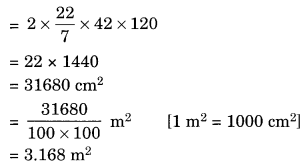
Area covered by the roller in one complete revolution = 3.168 m2
Area covered in 500 complete revolutions = 500 × 3.168 = 1584 m2
Hence, the required area = 1584 m2.
Question 20.
A rectangular metal sheet of length 44 cm and breadth 11 cm is folded along its length to form a cylinder. Find its volume.
Solution:
Circumference of the base = 2πr
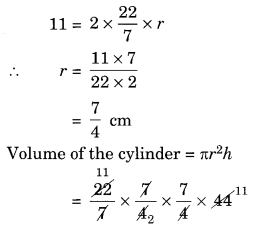
= 423.5 cm3
Hence, the required volume = 423.5 cm3.
Question 21.
160 m3 of water is to be used to irrigate a rectangular field whose area is 800 m2. What will be the height of the water level in the field? (NCERT Exemplar)
Solution:
Volume of water = 160 m3
Area of rectangular field = 800 m2
Let h be the height of water level in the field.
Now, the volume of water = volume of cuboid formed on the field by water.
160 = Area of base × height = 800 × h
⇒ h = 0.2
So, required height = 0.2 m
Question 22.
Find the area of a rhombus whose one side measures 5 cm and one diagonal as 8 cm. (NCERT Exemplar)
Solution:
Let ABCD be the rhombus as shown below.
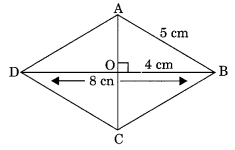
DO = OB = 4 cm, since diagonals of a rhombus are perpendicular bisectors of each other.
Therefore, using Pythagoras theorem in ΔAOB, AO2 + OB2 = AB2
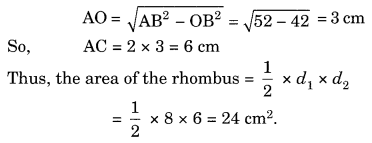
Question 23.
The parallel sides of a trapezium are 40 cm and 20 cm. If its non-parallel sides are both equal, each being 26 cm, find the area of the trapezium.
Solution:
Let ABCD be the trapezium such that
AB = 40 cm and CD 20 cm and AD = BC = 26 cm.
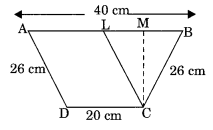
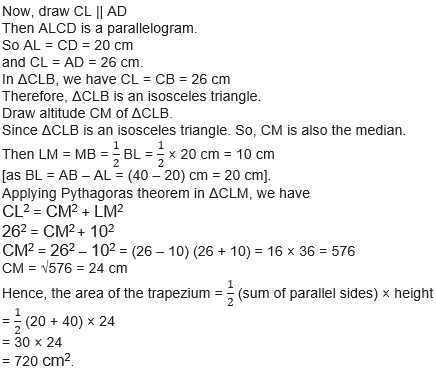
Question 24.
Find the area of polygon ABCDEF, if AD = 18 cm, AQ = 14 cm, AP = 12 cm, AN = 8 cm, AM = 4 cm, and FM, EP, QC and BN are perpendiculars to diagonal AD. (NCERT Exemplar)
Solution:
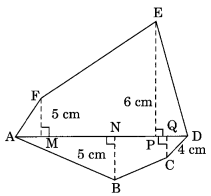
In the figure
MP = AP – AM = (12 – 4) cm = 8 cm
PD = AD – AP = (18 – 12) cm = 6 cm
NQ = AQ – AN = (14 – 8) cm = 6 cm
QD = AD – AQ = (18 – 14) cm = 4 cm
Area of the polygon ABCDEF = area of ∆AFM + area of trapezium FMPE + area of ∆EPD + area of ∆ANB + area of trapezium NBCQ + area of ∆QCD.
